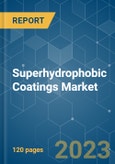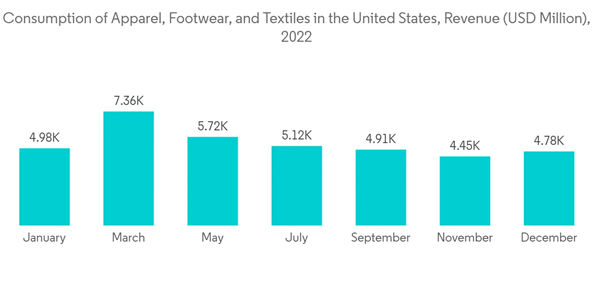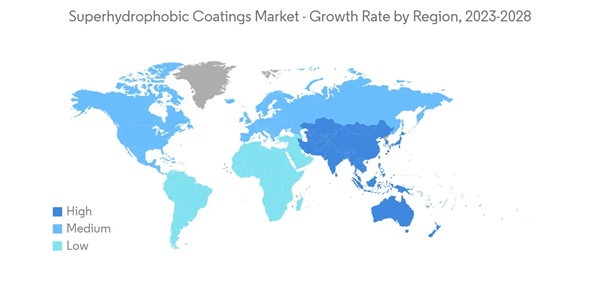The market for superhydrophobic coatings is expected to register a CAGR of 25.48% during the forecast period.
This product will be delivered within 2 business days.
Key Highlights
- COVID-19 negatively impacted the market in 2020. Owing to the pandemic scenarios, several countries worldwide went into lockdown to curb the spreading of the virus. The demand for superhydrophobic coatings from various end-user industries, such as textile and footwear, automotive, building, and construction, was severely affected due to a halt in their production processes. However, the condition recovered in 2021, benefiting the market growth over the forecast period.
- Increasing demand for electric vehicles and the growing demand from the textile industry are the major factors driving the market's growth. On the flip side, the contamination of surfaces with organic substances and biological residues during its production is expected to hinder the market's growth.
- The textile and footwear industry dominated the market and is expected to grow during the forecast period, owing to the increasing demand for advanced textile and high-end footwear. Growing demand from the solar industry is likely to act as an opportunity for the market in the future.
- The United States dominates the global market and will likely drive the demand for superhydrophobic coatings over the forecast period.
Superhydrophobic Coatings Market Trends
Textile and Footwear Segment to Dominate the Market
- During the past decade, various organizations have directed their research efforts to create stain-resistant textiles and water repellents. However, these coatings have been used for several years in raincoats. Currently, there is a huge demand for self-cleaning textiles.
- Using these coatings in the textile sector has greatly increased the potential to save water and energy needed in cleaning and the use of chemicals used in the manufacturing of cleaning agents. With reduced washing requirements, these textiles are expected to be long-lasting and more durable. Self-cleaning textiles are much better repellers of dirt than conventional fabrics and can degrade several types of stains based on some catalytic mechanism.
- Superhydrophobic textiles are most appreciated in hospitals since the self-cleaning technique of these garments will lead to avoiding pathogens, odors, microorganisms, etc. Hence, these textiles help reduce the chances of infection and the spread of diseases.
- These textiles also offer several benefits in the defense sector. Soldiers posted in difficult and inhospitable areas often need to get the chance to wash their clothes. Self-cleaning garments offer cleaner and more hygienic solutions for them.
- China is the largest textile-producing and exporting country in the world. With its rapid growth over the last two decades, the Chinese textile industry has become one of the main pillars of the country's economy. In February 2022, the Chinese textile export reached an all-time high of USD 24,741 million.
- Approximately three billion meters of clothing fabric were produced in China in October 2022. According to the National Bureau of Statistics (NBS), the textile production volume reached an all-time high of USD 46 billion in November 2022.
- The superhydrophobic coating has intense applications as antibacterial and antifogging, due to which it is extensively used in the footwear industry. In 2021, 22.2 billion pairs of footwear were produced around the world. Asia is responsible for over slightly less than 90% of global footwear production.
- Based on the aforementioned aspects textile and footwear segment will dominate the global superhydrophobic market.
United States to Dominate the Global Market
- The textile industry in the country, overall, has shown a positive trend due to the growing technical textile demand from various end-user industries, such as automotive and industrial applications.
- The US textile market is divided into three segments - apparel, which consumes nearly 12%. The home textiles and floor covering segment accounts for almost 40% of raw material consumption. Technical textiles hold the largest share, with nearly half of the raw material produced in the United States.
- The demand for technical textiles is also expected to remain high in the coming years due to growth in the global economy. The United States is the world’s largest apparel market. The country also imports textiles and clothing from China, India, Vietnam, Bangladesh, and Mexico.
- Moreover, the United States is one of the largest automotive manufacturers and boasts one of the largest construction industries, with the trillion-dollar plan from Biden Administration.
- The United States textile industry invested USD 20.2 billion in new plants and equipment from 2011 to 2020. Recently US manufacturers have opened new facilities throughout the textile production chain, including recycling facilities to convert textile and other waste to new textile uses and resins.
- According to the National Council of Textile Organizations (NCTO), in 2021, the value of United States man-made fiber, textile, and apparel shipments totaled an estimated USD 65 billion, compared to USD 60.8 billion in shipments in 2021.
- According to data from the Office of Textiles and Apparel (OTA), a division of the United States Department of Commerce, in the first half of 2022, the United States exports of textiles and clothing increased by 13.10% from the previous year. Compared to the same period in 2021, exports increased to USD 12.44 billion from USD 10.99 billion.
- Moreover, the United States regularly researches photovoltaics and concentrated solar power. It is among the top countries in the world in electricity generated by solar power. Hence, the United States is set to be the largest region in the global market during the forecast period.
Superhydrophobic Coatings Industry Overview
The global superhydrophobic coatings market is highly fragmented, with no single player occupying a major share of the market. The major players in the market (not in any particular order) include Rust-Oleum, NEI Corporation, UltraTech International Inc., P2i Ltd, and Cytonix, among others.Additional Benefits:
- The market estimate (ME) sheet in Excel format
- 3 months of analyst support
This product will be delivered within 2 business days.
Table of Contents
1 INTRODUCTION1.1 Study Assumptions
1.2 Scope of the Study
2 RESEARCH METHODOLOGY
3 EXECUTIVE SUMMARY
4 MARKET DYNAMICS
4.1 Drivers
4.1.1 Growing Demand from the Textile Industry
4.1.2 Increasing Demand for Electric Vehicles
4.2 Restraints
4.2.1 Contamination of Surfaces with Organic Compounds During Its Production
4.2.2 Other Restraints
4.3 Industry Value Chain Analysis
4.4 Porter's Five Forces Analysis
4.4.1 Bargaining Power of Suppliers
4.4.2 Bargaining Power of Consumers
4.4.3 Threat of New Entrants
4.4.4 Threat of Substitute Products and Services
4.4.5 Degree of Competition
4.5 Patent Analysis
5 MARKET SEGMENTATION (Market Size in Value)
5.1 Product Type
5.1.1 Anti-corrosion
5.1.2 Anti-icing
5.1.3 Self-cleaning
5.1.4 Anti-wetting
5.2 End-user Industry
5.2.1 Textile and Footwear
5.2.2 Automotive
5.2.3 Building and Construction
5.2.4 Upcoming End-user Industries
5.3 Geography
5.3.1 Asia-Pacific
5.3.1.1 China
5.3.1.2 India
5.3.1.3 Japan
5.3.1.4 South Korea
5.3.1.5 Rest of Asia-Pacific
5.3.2 North America
5.3.2.1 United States
5.3.2.2 Canada
5.3.2.3 Mexico
5.3.3 Europe
5.3.3.1 Germany
5.3.3.2 United Kingdom
5.3.3.3 France
5.3.3.4 Italy
5.3.3.5 Rest of Europe
5.3.4 Rest of the World
6 COMPETITIVE LANDSCAPE
6.1 Mergers and Acquisitions, Joint Ventures, Collaborations, and Agreements
6.2 Major Player Analysis
6.3 Strategies Adopted by Leading Players
6.4 Company Profiles
6.4.1 Aculon
6.4.2 Advanced Nanotech Lab
6.4.3 Beijing Neatrition Tech Co Ltd
6.4.4 Cytonix
6.4.5 DryWired
6.4.6 Lotus Leaf Coatings Inc.
6.4.7 Nanex Co.
6.4.8 Nasiol Nano Coating
6.4.9 NEI corporation
6.4.10 NTT Advanced Technology Corporation
6.4.11 P2i Ltd
6.4.12 Pearl Nano LLC
6.4.13 Rust Oleum
6.4.14 The Sherwin Williams Company
6.4.15 UltraTech International Inc.
7 MARKET OPPORTUNITIES AND FUTURE TRENDS
7.1 Growing Demand for Solar Panels
Companies Mentioned (Partial List)
A selection of companies mentioned in this report includes, but is not limited to:
- Aculon
- Advanced Nanotech Lab
- Beijing Neatrition Tech Co Ltd
- Cytonix
- DryWired
- Lotus Leaf Coatings Inc.
- Nanex Co.
- Nasiol Nano Coating
- NEI corporation
- NTT Advanced Technology Corporation
- P2i Ltd
- Pearl Nano LLC
- Rust Oleum
- The Sherwin Williams Company
- UltraTech International Inc.
Methodology

LOADING...










